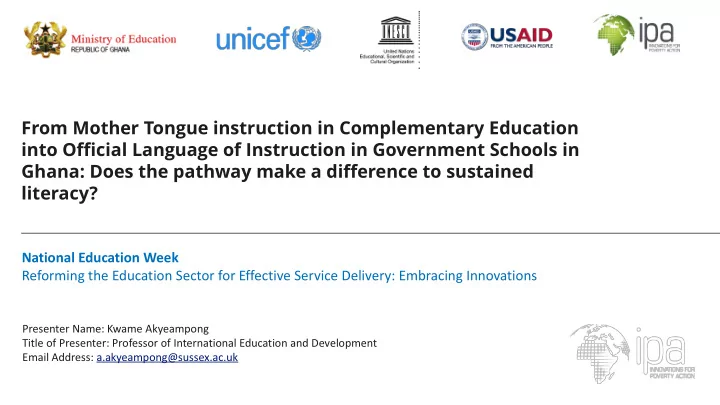

From Mother Tongue instruction in Complementary Education into Official Language of Instruction in Government Schools in Ghana: Does the pathway make a difference to sustained literacy? National Education Week Subtitle placeholder Reforming the Education Sector for Effective Service Delivery: Embracing Innovations Presenter Name: Kwame Akyeampong Title of Presenter: Professor of International Education and Development Email Address: a.akyeampong@sussex.ac.uk
The Policy Question What are the consequences for progression in literacy for children who experience alternative education in local language and then reintegrate into a system which uses a different language of instruction?
THE POLICY PROBLEM Two recommendations that are commonly put forward have potentially contradictory implications for language of instruction policy
The Policy Problem CBE Programmes are expected to have strong links with the government • education system to ensure effective reintegration into formal schooling (Longden, 2013; Gresham, et al. 2015). Yet the government education system in many multilingual environments is • usually taught in the national language, in a reduced number of local languages, or in English.
Our Study
Study We compare CBE children who continue with the same language of • instruction with those who either transition into a different local language or into English in government schools. We use data from 1,166 children who enrolled in the CBE programme and • then transitioned into government school, and assessed their foundational literacy skills during the CBE programme, and then reassessed them at the point of transition into government primary schools and again at the end of one school year.
The Four Scenarios 1a. Continuity : children who move into 2a. Continuity : children who are placed in primary grade 3 or below and into primary grade 4 or above and shift into an instructional environments where the same English dominated instructional environment local language as CBE is retained as the where the same local language as CBE is dominant language. studied as a subject. 1b. Discontinuity : children who move into 2b. Discontinuity : children who are placed in primary grade 3 or below and into primary grade 4 or above where English instructional environments where a different becomes the dominant language of local language to CBE is used as the instruction and a different local language to dominant language. that of CBE is studied as a subject.
What we were seeking to understand 1. At the point of transition, children who have discontinuities in their mother tongue education will show poorer local language literacy skills (scenarios 1b. & 2b. relative to 1a. & 2a.). 2. Children who transition into a different local language of instruction in primary grade 3 or below may be able to catch up in local language literacy while in government schools (scenario 1b. relative to 1a.). 3. Children who transition into primary grade 4 or above, where English is the language of instruction, experience detrimental impact on their local language learning (scenario 2b relative to 2a.).
OUR FINDINGS
FINDINGS 1 Children who transitioned into a different language of instruction had worse • performance in literacy at the start of government school, just after making the transition from the ten-month complementary education programme. This loss seems to be greater for reading comprehension for children who • transitioned into grades 4 and above, where English is the medium of instruction and the local language is taught as a subject.
FINDINGS 2 Children who transitioned into primary grades 3 and below, where local § language is still the main medium of instruction, managed to catch up in letter and sound identification and had similar rates of progress for reading comprehension relative to children who transitioned into the same language.
FINDINGS 3 Children who transition into schools where the medium of instruction is • English (i.e. grade 4) and a Ghanaian language taught is a local language different from their mother tongue somehow managed to close the achievement gap in reading comprehension. However, an average achievement gap in letter and sound identification and • in reading comprehension remained at the end of the first year in government schools between children who moved into schools where a Ghanaian language taught was their local language relative to a different local language from their mother tongue.
Key Policy Message
Policy Message Serious attention should be given to instructing children using the mother tongue as proficiency here improves the chances of children sustaining gains in literacy proficiency in multilingual learning environments in the government school system, even if initially they experience some difficulties at the point of transition.
Thank you
Recommend
More recommend